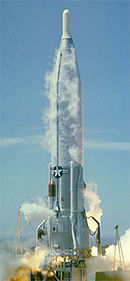List of Atlas LV3B launches
 | |
| Function | Crewedexpendable launch system |
|---|---|
| Manufacturer | Convair |
| Country of origin | United States |
| Size | |
| Height | 28.7 metres (94.3 ft) |
| Diameter | 3.0 metres (10.0 ft) width over boost fairing 4.9 metres (16 ft) |
| Mass | 120,000 kilograms (260,000 lb) |
| Stages | 1+1⁄2 |
| Capacity | |
| Payload toLEO | |
| Mass | 1,360 kilograms (3,000 lb)[2] |
| Launch history | |
| Status | Retired |
| Launch sites | CCAFSLC-14 |
| Total launches | 9 |
| Success(es) | 7 |
| Failure(s) | 2 |
| First flight | 29 July 1960 |
| Last flight | 15 May 1963 |
| Boosters | |
| No. boosters | 1 |
| Powered by | 2RocketdyneXLR-89-5 |
| Maximum thrust | 1,517.4 kilonewtons (341,130 lbf) |
| Burn time | 135 seconds |
| Propellant | RP-1/LOX |
| First stage | |
| Diameter | 3.0 metres (10.0 ft) |
| Powered by | 1RocketdyneXLR-105-5 |
| Maximum thrust | 363.22 kilonewtons (81,655 lbf) |
| Burn time | 5 minutes |
| Propellant | RP-1/LOX |
TheAtlas LV-3B,Atlas D Mercury Launch VehicleorMercury-Atlas Launch Vehicle,was ahuman-ratedexpendable launch systemused as part of the United StatesProject Mercuryto sendastronautsintolow Earth orbit.Manufactured by American aircraft manufacturing companyConvair,it was derived from theSM-65D Atlasmissile, and was a member of theAtlas family of rockets.[3]
The Atlas D missile was the natural choice for Project Mercury since it was the only launch vehicle in the US arsenal that could put the spacecraft into orbit and also had many flights from which to gather data. But its reliability was far from perfect, and Atlas launches ending in explosions were an all-too common sight at Cape Canaveral. The Atlas had also been originally designed as a weapon system, thus its design and reliability did not need to necessarily be 100% perfect. As such, significant steps had to be taken to human-rate the missile and make it safe and reliable unless NASA wished to spend several years developing a dedicated launch vehicle for crewed programs or else wait for the next-generationTitan IIICBM to become operational. Atlas' stage-and-a-half configuration was seen as preferable to the two stage Titan in that all engines were ignited at liftoff, making it easier to test for hardware problems during pre-launch checks.[4]
Shortly after being chosen for the program in early 1959, the Mercury astronauts were taken to watch the second D-series Atlas test, which exploded a minute into launch. This was the fifth straight complete or partial Atlas failure and the booster was at this point nowhere near reliable enough to carry a nuclear warhead or an uncrewed satellite, let alone a human passenger. Plans to human-rate Atlas were effectively still on the drawing board and Convair estimated that 75% reliability would be achieved by early 1961 and 85% reliability by the end of the year. Despite the Atlas' developmental problems, NASA had the benefit of conducting Project Mercury simultaneously with the Atlas R&D program which gave plenty of test flights to draw data from as well as test modified equipment for Mercury.[3]
Launch outcomes[edit]
Launch History[edit]
| Flight | Crew member | Mission name | Date | Outcome |
|---|---|---|---|---|
| 1 | Uncrewed | Mercury Atlas-3 | Tuesday, April 25, 1961 | Failure |
| First flight of theAtlas LV-3B.Was an uncrewed test flight. Resulted in failure. The cause remains disputed. | ||||
| 2 | Uncrewed | Mercury Atlas-4 | Wednesday, September 13, 1961
10:04 AM EDT[6] |
Success |
| Second uncrewed test flight. The launch was successful. | ||||
| 3 | Uncrewed | Mercury Atlas-5 | Wednesday Nov 29th, 1961
10:07 AM EST[6] |
Success |
| Final uncrewed test flight. Launch was successful. | ||||
| 4 | John Glenn | Mercury Atlas-6 | Tuesday, February 20, 1962
9:47 AM EST[7] |
Success |
| First crewed flight of theAtlas LV-3B.Successfully launchedJohn Glennto become the first American to orbit the Earth. First flight ofJohn Glenn. | ||||
| 5 | Scott Carpenter[8] | Mercury Atlas-7 | Thursday, May 24, 1962
8:45 AM EDT[7] |
Success |
| Second crewed flight of theAtlas LV-3B.First flight ofScott Carpenter. | ||||
| 6 | Wally Schirra[9] | Mercury Atlas-8 | Wednesday, October 3, 1962
8:15 AM EDT[7] |
Success |
| Third crewed flight of theAtlas LV-3B.First flight ofWally Schirra. | ||||
| 7 | Gordon Cooper[10] | Mercury Atlas-9 | Wednesday, May 15, 1963
9:04 AM EDT[7] |
Success |
| Final flight of theAtlas LV-3B.Final crewed flight of theAtlas LV-3B.First flight ofGordon Cooper. | ||||
| 8 | Alan Shepard | Mercury-Atlas 10 | October 1963[11] | Cancelled |
| Was to be second flight ofAlan Shepard.Was to be final flight of theAtlas LV-3B.Was cancelled because it was determined to be too risky.[12] | ||||
See also[edit]
Notes[edit]
References[edit]
- ^"Atlas LV-3B / Mercury".astronautix.Archived fromthe originalon 27 December 2016.Retrieved8 July2021.
- ^Wade, Mark."Atlas LV-3B / Mercury".Encyclopedia Astronautica. Archived fromthe originalon 11 November 2011.Retrieved24 November2011.
- ^ab"ch5".history.nasa.gov.Retrieved8 July2021.
- ^Limited, Alamy."Stock Photo – The Mercury Atlas rocket (officially designated the Atlas LV-3 B) was an Atlas D missile modified for Project Mercury launches".Alamy.Retrieved8 July2021.
- ^"1961-1969 Launch Schedule".Space Launch Schedule.Retrieved22 February2021.
- ^ab"1961-1969 Launch Schedule (Page 2)".Space Launch Schedule.Retrieved22 February2021.
- ^abcd"1961-1969 Launch Schedule (Page 3)".Space Launch Schedule.22 February 2021.Retrieved22 February2021.
- ^"May 24, 1962: NASA Astronaut Scott Carpenter Departs From Earth Aboard Mercury-Atlas 7".spacecoastdaily.Retrieved22 February2021.
- ^KSC, Lynda Warnock."NASA – Mercury-Atlas 8 (25)".nasa.gov.Retrieved22 February2021.
- ^"Mercury-Atlas 9 (Faith 7)".Supercluster.Retrieved22 February2021.
- ^"Cancelled spaceflight mission: Mercury 10".spacefacts.de.Retrieved3 March2021.
- ^"Mercury MA-10".astronautix.Archived fromthe originalon 28 December 2016.Retrieved3 March2021.


